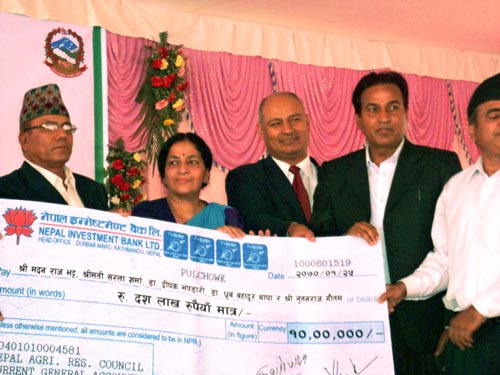 The Government of Nepal and the Nepal Agricultural Research Council (NARC) awarded Madan Raj Bhatta, Sarala Sharma, Deepak Bhandari, Dhruba Bahadur Thapa, and Nutan Raj Gautam — winners of the first-ever Borlaug Global Rust Initiative (BGRI) Gene Stewardship Award — for their outstanding contribution to food security through development and promotion of rust resistant wheat varieties in the country and for highlighting the country’s research globally. The award – one million Nepalese rupees (11,440 US$) and a plaque – was presented by the Minister of Agricultural Development Tek Bahadur Thapa Gharti on 8 May 2013 on the occasion of the 22nd anniversary of NARC in Khumaltar, Lalitpur.
The Government of Nepal and the Nepal Agricultural Research Council (NARC) awarded Madan Raj Bhatta, Sarala Sharma, Deepak Bhandari, Dhruba Bahadur Thapa, and Nutan Raj Gautam — winners of the first-ever Borlaug Global Rust Initiative (BGRI) Gene Stewardship Award — for their outstanding contribution to food security through development and promotion of rust resistant wheat varieties in the country and for highlighting the country’s research globally. The award – one million Nepalese rupees (11,440 US$) and a plaque – was presented by the Minister of Agricultural Development Tek Bahadur Thapa Gharti on 8 May 2013 on the occasion of the 22nd anniversary of NARC in Khumaltar, Lalitpur.
On behalf of the awardees, Bhatta and Sharma thanked the Government of Nepal and NARC for recognizing their contributions and praised the role of CIMMYT’s Global Wheat Program and BGRI in promoting agronomically superior rust-resistant wheat varieties crucial for food security in the region. “I am going to use 100,000 rupees of my prize money to establish a fund awarding two farmers or technicians every year for significant contributions towards wheat rust management,” said Sharma in her award acceptance speech. On behalf of CIMMYT, wheat breeder Arun Joshi congratulated the award-winning team and NARC for their remarkable contributions in bringing about excellence in development and release of rust-resistant wheat varieties, seed multiplication of resistant varieties with diverse genetic backgrounds, disease surveillance, participatory research with farmers, and improvement of livelihoods of small-scale farmers to combat the problems of food security.
“Wheat has played a great role in internal food supply in the country, a role equivalent to more than 26 billion rupees annually,” said B.B. Gurung, NARC executive director. “The new technologies and wheat varieties introduced by the team have brought a significant increment in wheat area and productivity in the last five years,” he added, referring to the increase in wheat area from 0.7 million hectares to 0.8 million, production from 1.4 million tons to 1.8 million, and productivity from 2.1 t/ha to 2.3 t/ha.
 Capacity development
Capacity development